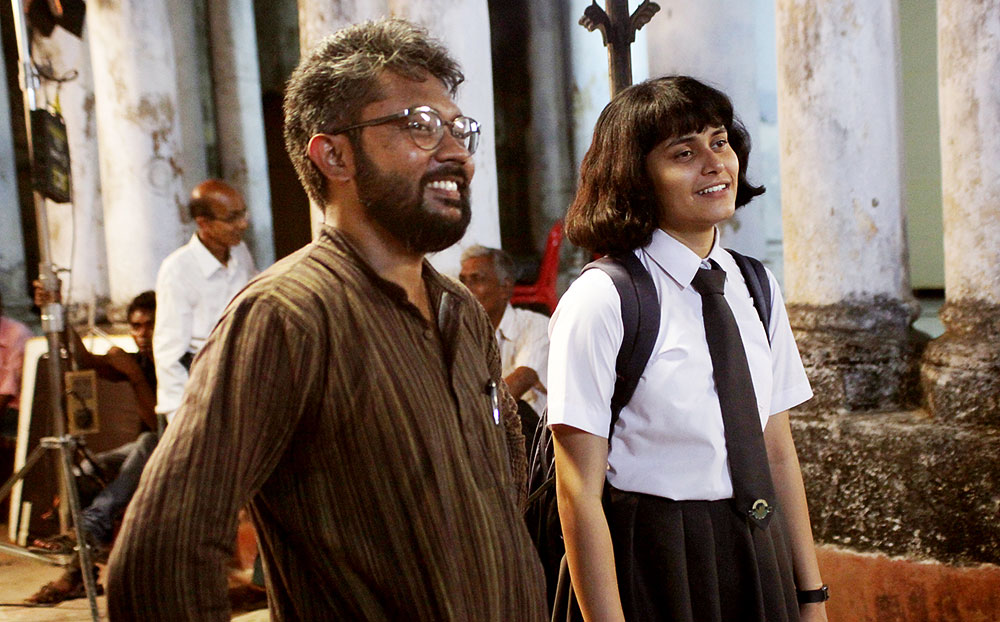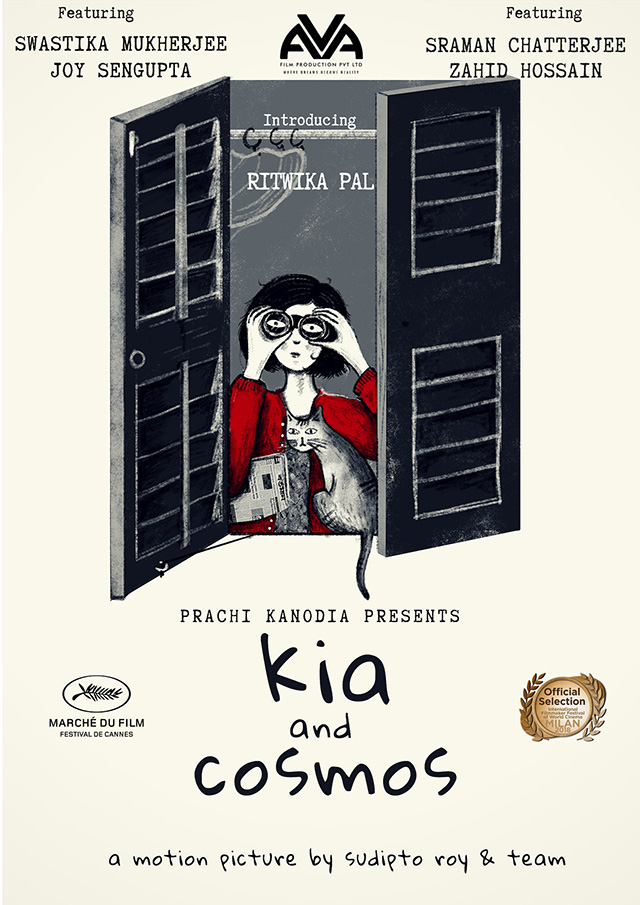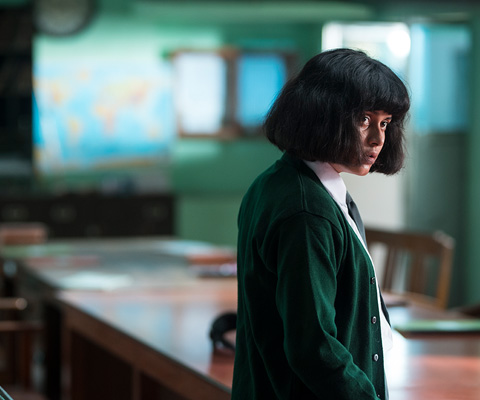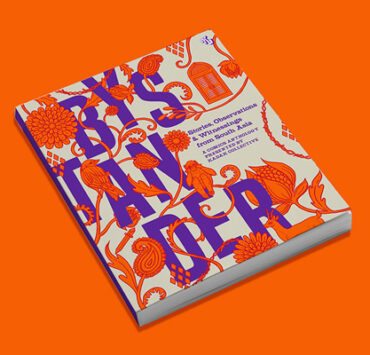Loneliness and loss, the ways in which people perceive absence, and the choices that emanate from them are some of the themes filmmaker Sudipto Roy explores in his new film Kia and Cosmos.
Truth and its potentially harmful and liberating qualities as well as the struggles of modern single parenting, the changing notions of family, the emergence of unlikely friendships, and the affirming nature of unusual and unusually-conducted social interactions are all deeply considered in this gentle and confident debut feature.
A detective- and spy-fiction aficionado and a ‘truth-seeker’ like her hero Byomkesh Bakshi, bright and wilful Kia is constantly perplexed by others’ need to lie and ends up unravelling more than the feline murder she singlehandedly sets out to investigate. Kia has a pair of red glasses through which she likes to see things. Not only do these glasses help remove all the abhorrent yellow around, they also stand in for the singular way in which she sees the world. In her small demarcated domain of narrow alleys, dingy attics and a neighbourhood school, objects hold as much fascination as facts. While shrinking from the touch of others, Kia’s own hands trail along walls and glass, tracing marks and seeking textures and fissures on the surfaces of objects. Red cars, a blue suitcase, an old tin box containing letters, and a diary that is lost and found are some of the things that populate her realm and hold within them whole worlds of secrets that Kia must uncover.

Ritwika Pal plays the titular character in the film. Photograph by Agniprava Nath.
Kia’s red glasses and the vibrant, distinct world she sees through them then are a stand-in for the camera, in a film which lets us view things as its teenage heroine views them — with immense wonder and curiosity and with complete unawareness of the compulsions that mire adult lives.
In a recent conversation with Helter Skelter, Roy spoke about his cinematic influences and what attracted him to his literary sources, creating a teenage heroine who is on the autism spectrum, and the kinds of Indian films making waves in the international arena.
How did this project come about and what was it that drove you to it?
I was a travel journalist and used to write for international magazines. I also made travel documentaries and a couple of short films (The Cemetery and B-Minor). This film was probably not planned as my first feature. I had about seven film scripts ready. I do write a lot and I developed the script around 2011–12. When I quit my 10 to 5 job and plunged into filmmaking, I started pitching stories to people and somehow this was the one that got the most attention.
There aren’t too many films made on teenagers. I have always wanted to tell stories about teenagers, their childhoods and conflicts. There is a certain baggage of the past as well as a hope for the future, both of which help shape those years in each individual’s life. It’s a confusing phase of our lives where we start revolting against teachers and parents, come up against ideas of good and bad as well as new emotions and also learn about sexual intricacies. It is a kind of building block for each person’s character and that was my driving force. I wanted to tell a story about a teenager.
The story of Kia and Cosmos is loosely based on works as varied as Mark Haddon’s The Curious Incident of the Dog in the Night-Time and Bankim Chandra Chattopadhyay’s Biral (The Cat). Tell me about some of the elements that attracted you most to these works which you then ended up adapting.
When it came to Bankim’s Biral, it was the meta element that I chose to focus on. In Biral, a socialist cat is complaining about society and arguing for its right to drink the milk that we have in our house. The cow doesn’t give us milk, we take milk from the cow. So, if we have the privilege of drinking the cow’s milk, the cat does too. It’s that meta part that I was interested in, where there is the idea that the cat’s life is also important. Why wouldn’t the police investigate a cat’s murder? Why shouldn’t we be concerned about why someone would kill a pregnant cat?

Sudipto Roy and Ritwika Pal. Photograph by Agniprava Nath.
I loved Mark Haddon’s book when I read it way back in 2010. I had asked Ritwika [Ritwika Pal, who plays Kia] to read it and had said that if I ever make a film on it, she would be playing the character. I had decided to flip the gender of the main character. The book was so lucid to me. It is about asking uncomfortable questions. It is also about an acceptance that what we define as ‘weird’ is okay, that it is absolutely fine if you are different or think differently, or if you do not connect with the norms of our present society. ‘Weird is okay’ became one of the catchlines of our film. And when it came to Bibhutibhushan Mukhopadhyay’s Ranur Pratham Bhag (The First Book of Ranu), it was the solitude of the child that interested me.
We see Kia in a lot of her quieter, more isolated moments. Looking at the way that solitude is depicted and also in terms of the film’s general whimsicality, use of colour and love for objects, there are reminiscences of Jean-Pierre Jeunet’s film Amélie. I was wondering about the influences on your style.
I actually haven’t watched Amélie. The only thing that I can directly relate to Amélie is probably the haircut that Ritwika got and that was suggested by Anisha [Mandal], my associate director, who had seen the film and who worked on Kia’s look. But the character is surely whimsical. She is at a stage in her life when things are topsy-turvy. She is in the mode of asking questions, she is continuously probing for the truth. I wanted to write a character who does not think that honesty is a virtue, but rather the norm.
A lot of Iranian films have influenced me in terms of my storytelling. I always want my stories to be low on flab. I like my characters to be assertive but not to shout. That is something I have learnt from Iranian films. My favourite filmmakers are Asghar Farhadi and Majid Majidi.
While one does sense that Kia is on the autism spectrum, what I found very refreshing about your take was that the condition is never exploited or used as an easy plot device. It’s a fact like so many other facts; it doesn’t define her or the story in any way. How did you stay away from that trap that so many mainstream Indian films seem to repeatedly fall into?
Thank you for addressing that. That was mostly at the level of the script. We were very cautious about the fact that we won’t sympathise with the character. Our main concern was that we shouldn’t misrepresent this wide spectrum, about which there is anyway very little awareness in our society. It was a wide spectrum of autism that we wanted to address and we never used the word ‘autism’ in the film. Whenever we used the word in our promotional campaign, it was to raise questions about why the subject is not spoken of widely. Even teachers do not know how to address this. We wanted people to watch the film and go back and research the condition so that they can talk about it in a medically accurate and well-informed manner rather than using words such as ‘abnormal’. The saddest part is that sometimes parents do not want to accept that their children have a condition which is like this. I have had conversations with some of them about not treating their children as ‘others’.
The film is told almost entirely from Kia’s perspective. Tell me about how you tapped into her mind.
There were two aspects: one was the process of tapping into a teenager’s mind, the other of tapping into a teenage girl’s mind. I have been around women from an early age and have seen some of the things that sisters and friends would argue about. I know how difficult it was even back in 2003–04 to talk about periods. If you were living with a single parent, it was difficult to talk about why the other parent was absent or why both parents had not attended a school function. These were elements that I thought were genuine and which leave an indelible mark on the minds of children. Some of it was my personal experience and then I spoke to my team members about how they grew up. We had a lot of discussion. There is a point in the film when Kia asks a neighbour about two of the film’s characters: “They were good friends. Does that mean that they were having sex?” These are pertinent questions, you know, that come to a teenager’s mind.
The film has a contemporary, urban feel to it in terms of the general look and the language, which is peppered with English dialogues, as well as with regard to issues around modern parenting and family structures; elements which still aren’t seen a lot in Bengali cinema. Was there a particular kind of audience you were looking to address?
When I am making a film, I am thinking of a global audience. It is important to understand that when we are considering Indian films that are making international debuts, it is mostly stories which are about the poorer sections of the society. Whether you look at the recent Village Rockstars or Pather Panchali, films that have been making a mark in the international arena, they are stories set in villages and about poor people. But India is not just about those things. There is the upper middle class Indian who is very aware of the globalisation around and the socio-political situation of the country and the world and of world music. That is one of the primary ideas that I had which was that if I am targeting the international audience along with my Indian audience, it should be about the middle class or upper middle class society and its struggles and conflicts which are often very difficult to point out.

Kia and Cosmos is releasing in the U.S.A. and in G.C.C. countries this month.
We all live in small boxes and in places where we have good furniture and polished walls but we have problems and distresses that we don’t understand and can’t share. In the nuclear family setup today, if there is a fight between a husband and a wife, there is no one to resolve it or give them a different perspective on things. Teenagers today have a deep-seated anguish and frustration about the way family lives are shaping up. There is not necessarily unhappiness about it but rather a lot of suppressed fear of confronting the truth. I personally struggle with that and wanted to see the story from that perspective.
The film also tries to delve into the intricacies of social boundaries; whether a middle class Bengali girl can be friends with a rickshawwala, whether a teacher who is probably gay can be a good companion and teacher to a girl who is fighting some mental issues.
Kia and Cosmos is mostly about the identity crisis that we all go through — about the father who is torn between the responsibilities of a family and the needs of a country, about the mother who tries to strike a balance between personal and professional lives. They all have crises around the issue of identity and that is true of our modern world and society. The film is trying to understand and probe [this], and it doesn’t give a resolution anyway.
———
Click here to watch the trailer for Kia and Cosmos.








